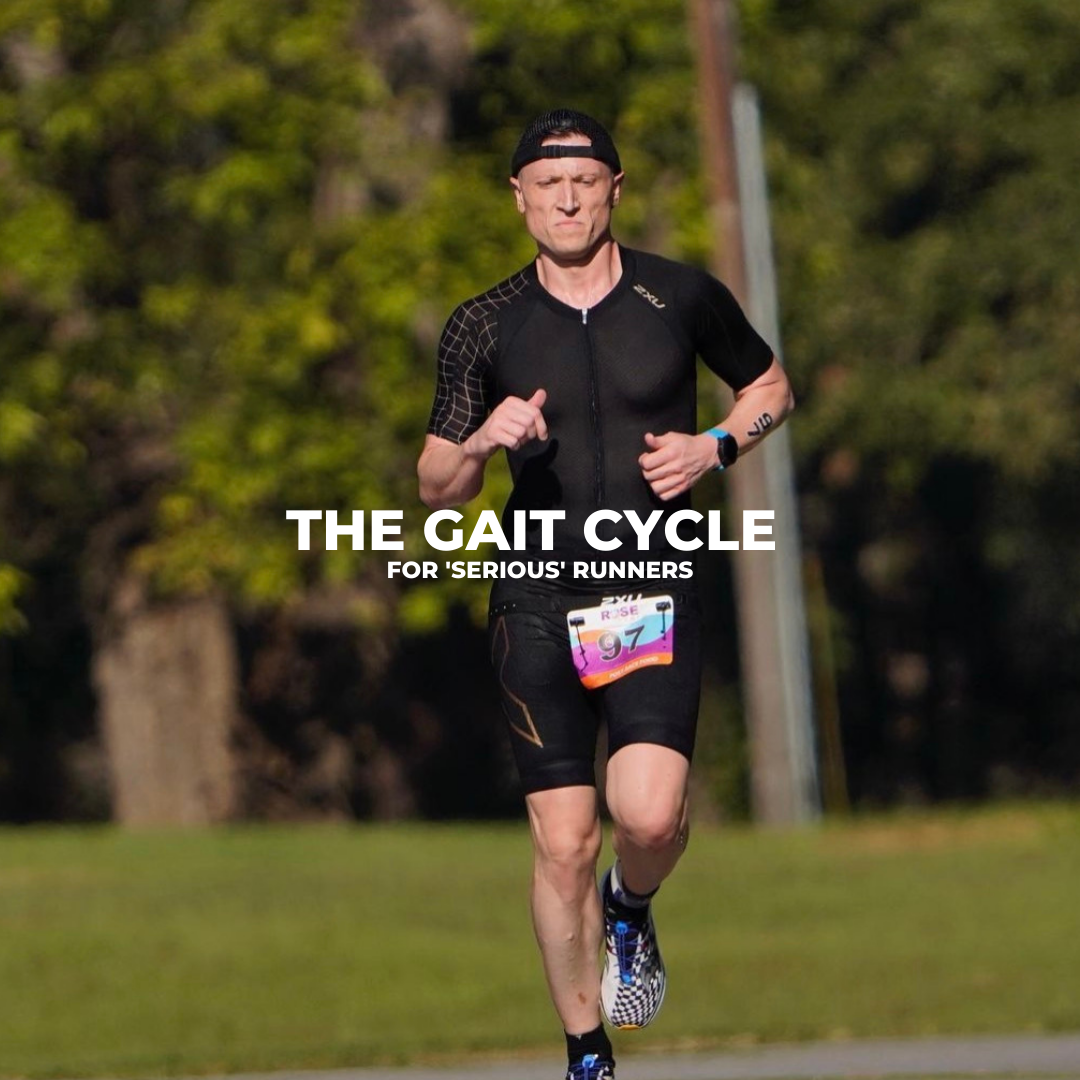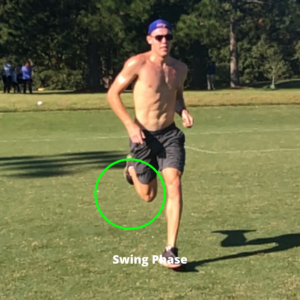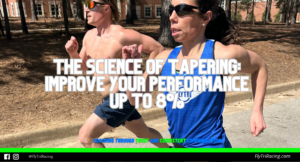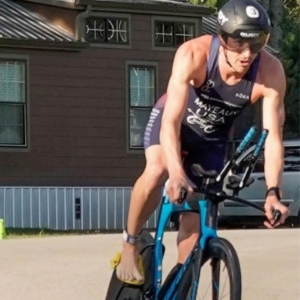
The Gait Cycle for ‘Serious’ Runners
In our last article we took you through the importance of running efficiency and how. This time we will take you through the gait cycle and how your form can be improved. The running gait cycle can be simplified into two main phases: the swing and stance phases with several sub-phases within each of these. (15)

The stance phase or support phase can be broken down to include the initial contact, midstance, and, finally, propulsion. The stance phase is basically the footstroke broken down. This phase can last between 156-168 ms in elite 800m runners (10). Moments before the foot strike at the foot is slightly dorsiflexed to preload just before the initial contact. The initial contact is the beginning of the stance phase when the foot strikes the ground either at heel strike, mid foot, or even forefoot for sprints. When the foot strikes this also causes braking and absorption. There is naturally some deceleration and we want to try to slow down as little as possible through the stance phase.
In the stance phase, the foot pronates and the knee flexes and goes to midstance, where the foot goes from pronation to supination and the body is moving forward over the leading foot. This is where maximum load occurs. This phase, unfortunately, is where the greatest risk of injury occurs in running. (12) Then finally, we go into propulsion or toe off phase. This is where the body goes into triple extension at the hips, knee, and ankle to push the body up and forward. The achilles/gastrocnemius complex is highly involved in this part of the stance phase and this makes up about 35% of the stance phase with 50% of the elastic energy coming from the achilles tendon. (15)


The swing phase is the second part of the gait cycle and it’s a passive movement from the heel traveling towards the butt as a function of hip extension and speed. It’s obvious when the foot is not in contact with the ground as it begins with toe off as the foot leaves the ground and ends when the foot strikes the ground. The hip extension is an act of driving the entire thigh of your leg backwards from the hip.
The swing phase is estimated to make 60% of the runner’s gait cycle (15). Steve Magness, University of Houston Coach says, “that the swing phase is like a stretch reflex mechanism similar to pulling back on a sling shot and letting go.” (10) There’s been great debate in recent years about whether you should force the swing phase through with greater hip extension and knee drive. However, I believe that to improve efficiency it tends to be best just to let it go passively as a function of the runner’s speed they are trying to run.

What affects hip extension is the degree at which you apply force as the foot contacts the ground and you drive your leg behind your body. The angle of hip extension depends on how far behind you your leg travels. A tight or weak hip can limit your hip extension. Once you have applied the force you then allow the rest of the hip extension to occur.
Following hip extension is the knee drive and it’s a direct result of hip extension because of the stretch reflex mechanism. (10) The more hip extension the greater the knee drive. You can think of knee drive as creating room in your stride. A knee up drive requires the pelvis to be neutral. There’s also been much debate if a runner should actively pull the leg underneath their butt or to let it happen naturally through the stretch reflex mechanism. You should let it be both while you are learning, especially as you learn the movement, so as to let it happen naturally. One thing to note is that the faster the pace the higher your heel will move towards your butt.
The next part that occurs with the strides is the unfolding of the lower leg. (10) The lower leg or foot should land close to underneath your hips. Many recreational runners may reach out with the lower legs with their feet landing in front of them. This may be due to tight hip flexors, not using their glutes, a lack of hip extension, or their feet not tracking towards underneath their butt. You do not want to rush or force the unfolding of the leg.
Stride Rate / Cadence
One of the most often discussed and debated topics in running is the stride rate. Stride Rate can be defined as the number of times the legs strike the ground. You have probably heard that 180 strides per minute is somehow the optimal number of strides each and every runner should be taking. This comes from a study done by Jack Daniels, a world renown running coach and exercise physiologist, conducted at the 1984 Olympics. (12) This study determined that elite distance runners (800m to Marathon) tend to strike the ground an average of 180 strides per minute. (That’s 90 steps with each foot). The main reason distance runners run faster is because of stride length. In Daniels’ study, he determined that male distance runners averaged 74” per stride and male sprinters were 93”. Female distance runners average 58” and female sprinters average 80” per stride.
When it comes to beginners and even sub-elite runners, very few average close to 180 steps per minute, with many beginning runners turning over as little as 140 to 170 steps per minute. The main disadvantage of a lower stride rate is that you can displace your body higher by spending longer time in the air and thus striking the ground harder. There is an association with running injuries and the magnitude of vertical impact forces. (12) It’s typically viewed that if you have a stride rate of less than 160 you are overstriding, although this will depend on the speed of the runner, too.
By converting to a higher stride rate you will eventually become more efficient, however, in the beginning there may be an increased short-term metabolic demand as you adapt to a faster cadence. Also, a higher cadence could have less impact shock which would cause a decrease in impact loading rate and a decrease in the eccentric knee joint loads, particularly of the patello femoral joint that can cause runners’ knees and the tibio femoral joint.
The theory that came from Daniels’ study suggesting that the optimal stride rate was 180 gave way to the belief that the stride rate should be largely based on the speed of the runner. One thing to keep in mind is that the shorter the race the higher the stride rate. For example, when Daniels did his study the fastest turnover rates were the 800 meter specialist, followed by the next longest distance. Sprinters have an even much higher turnover rate. When you are practicing to improve your stride rate on normal easy endurance runs consider only increasing by no more than 5%. When practicing don’t let the fact that you’re increasing your stride rate force you to run faster. Try to keep the same pace but at your quicker stride. Soon you will find it becomes more natural. The main point is don’t try to seek a perfect number. Aim for a stride that feels fluid, perpetual, economical and one that feels like you’re not reaching out in front of you with your lower leg. You can add short cadence-focused reps at your target cadence with a metronome. For confirmation, you could even use your heart rate monitor (or power meter) on various segments to see where you have a lower heart rate (or lower power) with the changes in cadence. To change your cadence takes consistent practice and focus before it will become natural and comfortable to you.
Now that you know stride rate is most often impacted by the distance of run, i.e., the shorter or faster the race the higher the stride rate will be. The next variable is stride length. There are many variables that go into stride length such as age, leg length and hip mobility. Mobility is a huge deal especially as we age as many of us sit at desks. Mobile and supple hips can be achieved through stretching, but even better hip mobility can be achieved through dynamic ranges of motion and focused strength training programs.
One of the most important things when it comes to your stride is to be sure that you’re not overstriding, thus heel striking, as this is one of the leading causes of injuries. If you include the form principles we have mentioned above you will find overstriding with a significant knee drive (relative to your effort) and good heel return with your foot dorsiflexed.
LANDING
When your foot lands, whether you land on your midfoot or heel, what is important is that your whole foot makes full contact underneath your hips (or very slightly in front). What this does is allows your joints to move in a more efficient position and it disperses the load so you can absorb the force and quickly transition to propulsion to your next stride. When you land there will also be some hip drop to absorb the shock of the landing (too much hip drop is another topic). We drive our foot down as we stiffen our arch, hips, and knees in order to push off to the next stride.
I always freak out when one of my runners tells me they are purposefully trying to land on their forefoot or midfoot. Take it from me, this is a great way to end up with metatarsal stress fractures. Trying to change how your foot hits the ground is a flawed concept;all you’re doing is placing the load elsewhere in an area less capable of adapting. Foot strike itself is a byproduct of your posture, hip extension, cadence, where your foot lands from your center of mass, and also by how fast you run. Your footstrike isn’t a concern as much as to where and when your foot lands. What’s NOT recommended is a forefoot strike, especially if the heel never contacts the ground. Trying to change your natural footstrike can also cause you to be less efficient. Research has shown that forcing changes to your running form actually can worsen performance, even after 3 months or more.
Two questions I get asked a lot are `Is one foot strike better than the other,” and “Is heel striking bad?” This is always one of those “it depends” answers. A proper foot strike and running efficiency are not so much a question of what part of the foot strikes the ground first, but how close is the initial contact underneath the center of mass. The fact is that many runners’ heels strike too far in front of their center of mass. This is also affected by your fatigue and the lack of hip extension as fatigue increases.
In 2009, Pete Larson did a study (11) at the 2009 Manchester Marathon and found that at the 10k mark of 936 runners, 88.9% runners were heel striking, 3.4% were midfoot striking, and 1.8% were forefoot striking and 5.9% had an asymmetrical strike. Then, by the 20 mile mark 93% of those runners were heel striking.
Many runners believe if you midfoot strike this will reduce the impact of the landing. Jay Dicharry (6) , the author of “Running Rewired” and “Anatomy of Runners,” has determined that is not the case and that forefoot and midfoot striking isn’t any less jarring than a prominent heel strike. What Dicharry did determine though was that a midfoot strike had two impact peaks which were quite forceful, while a heel strike was more gradual. What is important to remember is that a heel strike close to your center of mass with a slightly bent knee caused no overloading. If you land hard this could lead to a lot of injuries. What I don’t recommend for distance runners is a prominent forefoot strike, especially when the heel doesn’t touch the ground as this would lead to all sorts of injuries from achilles, calves, knees, and on up the kinetic chain. Some researchers have even said that some heel strikers are more efficient because of the rolling action of the heel as it absorbs force efficiently as a striking midfoot with or without shoes. Clearly, there is not a one-size-fits-all approach for every runner.
Vertical Shins: What we can agree on is that it’s more important that the foot lands close to under the center of mass. When you land you typically want to land with a vertical shin angle or a knee that is just slightly forward. If your shin is ahead of you and you’re kicking dirt and rocks forward that’s a strong sign you are over striding. Ideally, you would want to land with a vertical 90 degree shin angle close to underneath the hips. This would reduce the braking forces and disperse the load. Many runners who overmstride may need to work on this, especially runners who have cadences under 150 – 160 steps per minute for their easy paces.

Knee Flexion in Midstance:
When we are in midstance another important part to think about (but not overthink 🙂 is knee flexion. If our knee is flexing too much, say, greater than 25 degrees, this would cause us to overcome the height we lose into the ground and increase our pelvic drop. You essentially want to extend your leg down and under while pushing your contralateral hip up. Easier said than done, but this gets less difficult as you become more experienced, get faster and stronger, and can also be accelerated with drills that help you get your foot down faster, like A-Skips for example.
Pronation: When your foot lands it pronates. This is a natural process and it is essential for loading and unloading the arch. In fact, the achilles and plantar fascia make up about 50% of the elastic energy that is stored. (7) Pronation is necessary for runners to absorb the force and then supination is important for force production.
However, overpronation (excessive eversion ) must be dealt with typically by decreasing ground contact time, supportive footwear, or conditioning. Overpronation is typically greater than 15-18 degrees when the foot is in mid-stance and landing laterally on the outside of the foot. (7)
Overpronation could result in more stress and strain of the foot and lower leg, which causes such injuries as plantar fasciitis, achille tendonitis, and patellar tendonitis. On the other hand, a limited amount of eversion or loading too quickly could result in injuries like lateral ankles sprains and IT Band Syndrome. (7) There are definitely a lot of conflicting scientific studies regarding pronation and more studies are needed to further investigate and understand the cause and effect relationship associated with the function of pronation and the running injuries.
The Great Big Toe
Your big toe is an essential piece to a strong push off here. Your big toe needs to be flexible enough to allow for a strong push-off. According to Jay Dicharry, the big toe should be able to extend at minimum 30 degrees. (6) If you can’t extend to 30 degrees then your plantar fascia could be too tight in this regard. Having proper range allows you to roll straight off the ball of the foot at toe-off, rather than cutting your toe-off short.
Do you need strength training?
Do you need strength training for improved running? There was a study done that studied hip mechanics of runners. (12) There was a control group that did no strength training and there was a standard group that did general strength training. What they found was that for the group that did general strength training there was no change in their hip mechanics.
Strength work alone isn’t going to change your biomechanics. You can still run very well without having to add in strength training. The strength work is the precursor to being able to make the necessary biomechanical changes. You still need the strength training to have the proprioceptive awareness to make those changes.

You can still improve your form without having to strength train but the challenge is being able to maintain your form for an extended period of time or at a certain pace. Ideally, you want to finish a fatiguing run with the same excellent form you started the run with. So, strength training could be really useful and something to consider.
Keys to making change
Technique changes need to occur gradually as you will be more effective if you focus on one particular element or biomechanic change at a time. Focusing on one change at a time allows you to adapt the changes in form or a new drill gradually. This is because you need time to develop the proprioceptive awareness of what the element should feel like. In other words the changes you make should feel as if they are second nature now. If you’re trying to think and do too many things at once you would be forcing the movement and it will look and feel awkward.
Think repetition. The “myelination principle” as we repeat something the more neural pathways we develop through constant repetition. In Daniel Coyles book “The Talent Code” (5) The thicker the myelin gets, the better it insulates, and the faster and more accurate our movements and thoughts become automatic.
Sometimes it may also be best to leave form alone. In Matt Fitzgerald’s book, The 80/20 Principle, (9) he discusses how it’s best to have a “relaxed” stride as you increase your mileage and you become better and more relaxed over time.
GET VIDEOED
Perception is often not reality especially when we hear our voice on an audio recording or see a video of ourselves. When we do swim analysis on our triathlete swimmers we often tell them the video will help them see what they are actually doing, because what they see in their head is often not what they are really doing. The video never lies. Even when I see photos or videos of myself running, I rarely look like what I saw in my mind. When you video yourself running, consider filming from all multiple directions such as the front, sides, and rear views. Also, consider videoing under race pace conditions and when you are fatigued. Typically, the faster we go and as we fatigue our form gets worse. Getting yourself videoed will quickly bring awareness of your form and how you can potentially improve.
Add a lot of Strides & Hills
In addition to watching yourself on video, two of the fastest ways to improve your running form is through a lot of strides, hill sprints, and hill reps. Unlike dynamic warmup drills (ex: high knees, butt kicks) that are great for warming up the body in various ranges of motions, they have little to do with actually improving running form. Running is a whole, continuous motion and can therefore be improved a lot faster with cues, cognitive awareness and focus. Now that you have a video of yourself as a reference point that you can take with you on your training, two of the fastest ways to improve form is through strides and hill reps. These drills will improve your neuromuscular efficiency and improve your form to where it feels as if it is second nature. Fast strides are great to work on posture and cadence. And hills can force your body in an optimal position which is great for also improving posture, arm carriage, knee drive, and plantar flexion power.
In addition to strides and hills, you should also work on your form in your everyday runs. You can also include “interval training” with run form such as focusing one minute “on” where you’re working on some aspect of your form such as arm carriage, and then one-minute “off” where you shut your mind off and just run.
In conclusion, there is no right or perfect way to run. What is important is that you find what works best for you with the body you have been given as you evolve as a runner or triathlete with your training. Go video yourself, have a look, and find things you can improve and focus on. Use strides and hills to improve your form. Build your volume and frequency gradually and consistency and you will find yourself setting your next PR.
Resources
- The Running Gait Cycle Explained, https://www.runnersblueprint.com/running-gait-cycle/#:~:text=Mid%20Stance,foot%20is%20in%20swing%20phase.
- Baltich, Jennifer, and Christian Maurer. Increased Vertical Impact Forces and Altered Running Mechanics with Softer Midsole Shoes, vol. Plos One 10 (4), no. e0125196, 2015. https://doi.org/10.1371/journal.pone.0125196.
- Breine, Bastiaan, et al. Initial foot contact patterns during steady state shod running. 1 ed., vol. 5, Footwear Science, 2013, https://www.tandfonline.com/doi/full/10.1080/19424280.2013.799570#.Ugp07JIm0sc.
- Coyle, Daniel. The Talent Code: Unlocking the Secret of Skill in Sports, Art, Music, Math, and Just About Everything Else. Highbridge Company, 2009.
- Daniels, Jack. Daniel’s Running Formula. 2nd ed., Human Kinetics, 2005.
- Dicharry, Jay. Running Rewired: Reinvent Your Run for Stability, Strength, and Speed. VeloPress, 2017.
- Dierks, Tracy A. “Pronation in runners: Implications for injury.” Lower Extremity Review, June 2011, https://lermagazine.com/article/pronation-in-runners-implications-for-injury#.
- Dixon, Matt. The Well Built Triathlete. Boulder, CO, Velo Press, 2014.
- Fitzgerald, Matt. 80/20 Running: Run Stronger and Race Faster by Training Slower. Penguin Publishing Group, 2014.
- Magness, Steve. The Science of Running. Origin Press, 2014.
- Mateo, Ashley. Should You Change Your Stride Length? Runner’s World, 2020, https://www.runnersworld.com/training/a32907031/stride-length/.
- Runner’s Connect. Running Form Course. www.runnersconnect.net.
- Schubert, Amy, et al. “Sports Health.” Influence of Stride Frequency and Length on Running Mechanics, vol. v.(6) 3, no. May, 2014, pp. 210-217. https://www.ncbi.nlm.nih.gov/pmc/articles/PMC4000471/#:~:text=Running%20is%20a%20popular%20activity,the%20United%20States%20run%20weekly.&text=Approximately%2056%25%20of%20recreational%20runners,running%2Drelated%20injury%20each%20year., PMC4000471.
- Simmons, Andrew. Unlocking Free Speed. 2020.
- Thompson, Dave. Conventions for naming parts of the gait cycle, https://ouhsc.edu/bserdac/dthompso/web/gait/terms.htm.



